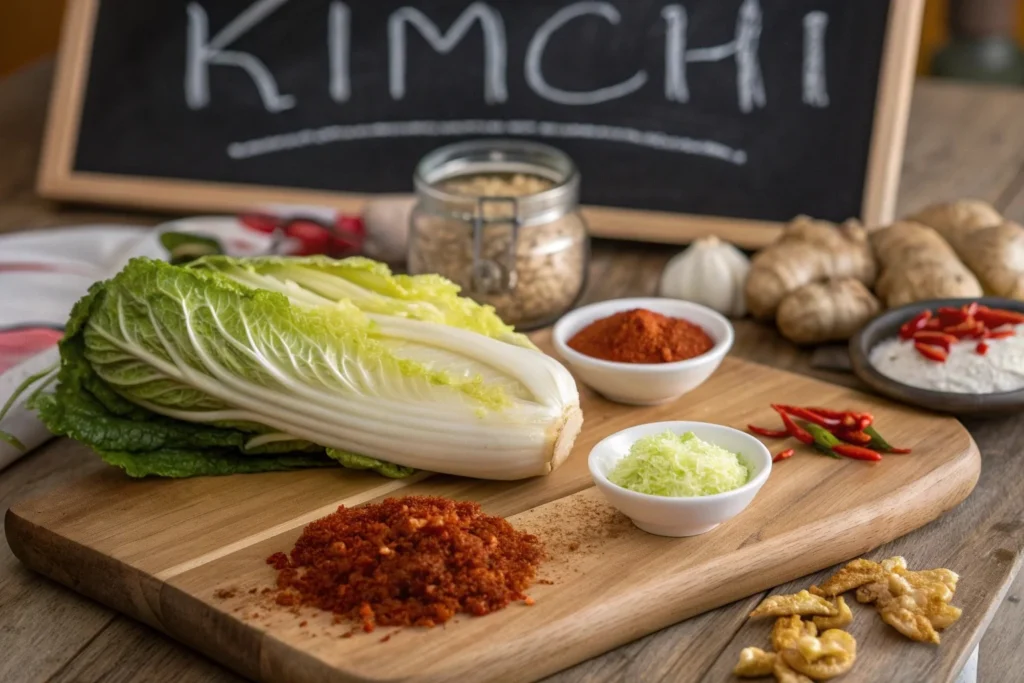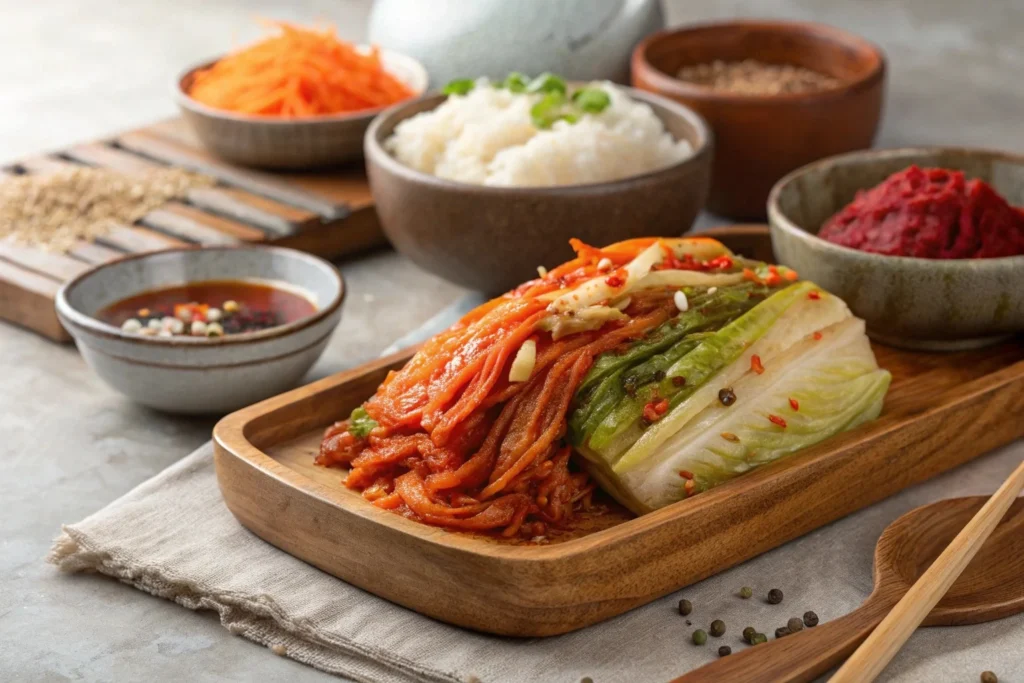Imagine tasting a dish that takes you to another world. For many, that dish is kimchi—a cultural staple of Korean food. It brings life to every meal with its spicy, tangy, and savory flavors. Preparing authentic Korean cuisine means more than just cooking. It connects you to history and tradition. This guide offers an easy kimchi recipe to explore Korea’s rich culinary heritage in your kitchen. Enjoy the bold flavors of *traditional kimchi* with rice, in stews, or as a vibrant side dish. Let’s start this delicious journey together!
Table of contents
Introduction to Kimchi
Kimchi is more than a dish in Korean culture. It has a long history, starting from simple salted veggies to a flavorful staple. This introduction to kimchi shows how it has become a key part of Korean cuisine.
Kimchi was first made to preserve veggies during cold winters. Now, it comes in many flavors and textures. What is kimchi is a fermented food, often with cabbage, radishes, and spices. It’s a gateway to new tastes.
Trying a kimchi food recipe lets you explore different flavors. Making kimchi is all about creativity, letting you customize it to your taste. This journey not only teaches you about kimchi’s history but also invites you into Korean cooking traditions.
The Importance of Traditional Korean Cuisine
Traditional Korean cuisine is key in family life, during gatherings and celebrations. Kimchi is a big part of meals, showing the heart of Korean food culture.
Kimchi’s role goes beyond taste. It connects us to the seasons, showing respect for nature’s rhythms. Exploring Korean food, you see how each ingredient is chosen for taste and health benefits.
In every home, sharing meals with kimchi is a treasured tradition. It brings families together, celebrating food and culture. Traditional Korean cuisine is a legacy that lasts, with kimchi at its core.
What is Kimchi?
Kimchi is a key part of Korean food, loved for its mix of tastes and textures. It has a long history in Korean culture, dating back over a thousand years. To understand kimchi, we must look at its past and the many ways it has changed over time.
Understanding the Origins of Kimchi Recipe
The story of kimchi has many chapters, showing how ingredients, methods, and culture have evolved. At first, it was a way to keep veggies fresh during winter. Recipes were simple, using seasoned veggies to feed families.
As Korean society grew, so did kimchi recipe. It started to include spices like red pepper and garlic, making it more complex.
Diversity of Kimchi Varieties
Now, kimchi comes in many forms, each with its own taste and story. You can find different types like napa cabbage and radish kimchi. Each has its own flavor, thanks to the ingredients and how it’s made.
There’s also fresh kimchi, which is lighter and uses veggies that haven’t been fermented as long. This shows the variety and creativity in kimchi making.
Essential Kimchi Recipe Ingredients
To make real kimchi, you need certain ingredients. Knowing the common vegetables and spices is key. This will help you make a tasty batch.
Common Vegetables Used
Kimchi starts with a few main vegetables. Here are the most used ones:
- Napa cabbage: It’s the classic base, giving a crunchy feel.
- Radishes: Daikon radishes add a sweet taste and crispness.
- Green onions: They bring a fresh onion flavor, boosting the taste.
Spices and Seasonings for Flavor
The flavor of kimchi comes from spices and seasonings. Here are the main ones:
- Korean chili powder (gochugaru): It adds heat and a red color.
- Garlic: Minced garlic adds a deep, aromatic flavor.
- Ginger: It adds freshness, matching the garlic.
- Fish sauce: It brings umami, making the flavor richer.

Korean Kimchi Dish: A Cultural Staple
Kimchi is a big deal in Korean food culture. It’s not just about taste; it’s a symbol of tradition. It brings people together, whether it’s for a casual meal or a big celebration.
At any meal, kimchi recipe makes it special. It’s not just a side dish; it’s the star. It adds bold flavors and textures to your meal. Sharing kimchi-filled meals creates memories and strengthens bonds.
Kimchi is also good for you. It’s full of probiotics, which help with digestion. Eating kimchi lets you connect with Korean culture and feel good at the same time.
Easy Kimchi Recipe for Beginners
Making kimchi recipe at home is a fun and rewarding experience. This easy recipe is great for beginners. It uses simple ingredients and easy steps, so you can make your own kimchi without stress.
- 1 medium Napa cabbage
- 1/4 cup sea salt
- 4 cups water
- 1 tablespoon grated ginger
- 4 cloves garlic, minced
- 2 tablespoons sugar
- 1/4 cup gochugaru (Korean red pepper flakes)
- 2 green onions, chopped
Here’s how to make your own beginner-friendly kimchi:
- Cut the Napa cabbage into quarters and remove the core. Then, chop it into bite-sized pieces.
- In a large bowl, mix the sea salt with water. Soak the cabbage in this salted water for about 2 hours, turning it occasionally.
- In another bowl, combine the garlic, ginger, sugar, and gochugaru to make a paste.
- After two hours, rinse the cabbage under cold water and drain it. Then, mix the cabbage with the spice paste and green onions well.
- Pack the mixture tightly into clean jars, leaving some space at the top for fermentation.
- Let the jars sit at room temperature for 1-2 days to ferment. Then, store them in the fridge.
Enjoy your homemade kimchi recipe as a side dish or in various recipes. This easy kimchi recipe lets you explore Korean flavors from home.
Kimchi Fermentation Process
The kimchi fermentation process is a fascinating journey. It turns fresh vegetables into a tangy, flavorful dish. Beneficial bacteria develop during this time, which is key to the kimchi’s taste and preservation.
How Fermentation Enhances Flavor
During fermentation, natural sugars in the vegetables turn into lactic acid. This change gives kimchi its sour taste and adds depth. The live cultures from this process make the dish more flavorful, elevating any meal.
Timeframe for Perfect Fermentation
Finding the right fermentation time is key for the flavor you want. Kimchi can be fermented for a short time for a fresher taste or longer for a deeper flavor. Here’s a general guideline:
- 1-2 days at room temperature for a mild taste.
- 3-7 days for a balanced sourness.
- 1-2 weeks for a stronger fermentation flavor.
Trying different times can help you find your favorite kimchi taste. Remember, the process is not just about taste. It’s also about growing beneficial bacteria that improve flavor and quality.
Homemade Kimchi: Step-by-Step Instructions
Making homemade kimchi recipe is a fun cooking adventure. With simple steps, you can start this tasty journey. This guide will help you prepare and store your kimchi to keep it fresh.
Preparation Steps
To make your own homemade kimchi recipe, follow these steps:
- Gather all ingredients, including fresh cabbage, radishes, garlic, ginger, and your preferred spices.
- Prepare the cabbage by cutting it into quarters and soaking it in a saltwater solution for a few hours to enhance the flavor.
- After soaking, rinse the cabbage thoroughly under cold water and drain well.
- In a separate bowl, mix garlic, ginger, chili powder, and any additional spices to create a paste.
- Combine the soaked cabbage with your spice paste, ensuring each piece is well-coated.
- Pack the kimchi tightly into clean glass jars, leaving some space for fermentation gases to expand.
- Seal the jars and leave them at room temperature for 1-3 days, depending on your taste preference.

Storage Tips for Freshness
Proper storage can extend the life of your kimchi:
- Once fermentation is complete, transfer the jars to the refrigerator.
- For optimal freshness, consume your homemade kimchi within 1-2 months.
- Keep the kimchi submerged under the brine to prevent exposure to air, which can lead to spoilage.
Vegan Kimchi Recipe Variations
Enjoying vegan kimchi recipe is easy when you follow a plant-based diet. You can make traditional kimchi vegan by swapping out non-vegan ingredients. The result is a dish full of unique flavors that capture the essence of kimchi.
Substitutes for Traditional Ingredients
Looking to make vegan kimchi? You’ll need to find alternatives for common ingredients. Instead of fish sauce, try:
- Soy sauce
- Miso paste
- Coconut aminos
These options keep the umami taste while making the kimchi vegan. You can also swap sugar for maple syrup or agave nectar to boost the flavor.
Flavor Profiles for Vegan Options
Vegan kimchi recipe can be just as flavorful as the traditional kind. Try adding different spices and aromatics for a unique taste. Consider using:
- Garlic and ginger for a zesty kick
- Chili flakes or Korean gochugaru for spice
- Sesame oil for a nutty scent
By mixing these ingredients, you can create a vegan kimchi that’s both satisfying and delicious. Explore vegan ingredients and discover new favorite flavors.
Spicy Cabbage Kimchi: A Popular Choice
Spicy cabbage kimchi recipe is a favorite among many. It’s made with napa cabbage, which is prepared in a special way. This ensures a mix of spices and tanginess that people love. The main ingredients are:
- Napa cabbage
- Korean red pepper flakes (gochugaru)
- Garlic and ginger
- Fish sauce or a vegan alternative
- Green onions
To make spicy cabbage kimchi, start by salting the cabbage. This step removes moisture, making it crunchier and tastier. Next, mix gochugaru with garlic, ginger, and fish sauce to create a spicy paste. Coat the cabbage well with this paste, so every leaf is flavored.
This kimchi is not just tasty but also good for you. It’s full of probiotics, vitamins, and minerals. It’s great as a main dish or a side that adds excitement to any meal.
Kimchi Food Recipe: Bringing Authenticity to Your Kitchen
Want to make your meals more exciting? Try adding an authentic kimchi food recipe. This Korean side dish brings a burst of flavor. It turns simple dishes into memorable meals.
Here are some tasty ways to add kimchi to your food:
- Kimchi Fried Rice: Mix leftover rice with veggies, tofu or chicken, and kimchi. It’s a quick, flavorful dish.
- Stews: Add kimchi to stews or soups. It boosts the flavor and adds a tangy twist.
- Tacos: Top tacos with kimchi. Its spicy and sour taste adds a unique flavor to any filling.
Try traditional cooking methods to find new kimchi combinations. Being creative in the kitchen can lead to amazing discoveries. Start exploring authentic Korean flavors in your own kitchen!

Conclusion
Exploring authentic kimchi recipe is more than just tasting a dish. It’s a journey into Korean cuisine’s rich heritage. Learning about kimchi’s importance, its many types, and special ingredients deepens our appreciation for it. The recipes and tips shared help you make these flavors at home.
This journey invites you to dive deeper into Korean cuisine by making your own kimchi. Embracing fermentation opens a world of bold flavors that can make any meal better. Sharing your creations with friends and family adds to the fun, connecting through homemade dishes.
Kimchi is an exciting world to explore, whether you’re an experienced cook or new to it. Trying authentic kimchi recipes lets you join a culinary tradition loved for generations. Enjoy the journey, relish the flavors, and share your adventure into Korean cuisine.
FAQ
What is kimchi?
Kimchi is a Korean side dish made from fermented veggies like Napa cabbage and radishes. It’s seasoned with spices like Korean chili powder, garlic, and ginger. The fermentation process makes it taste better and adds probiotics.
Is there an easy kimchi recipe for beginners?
Yes! A simple kimchi recipe for beginners uses Napa cabbage, salt, Korean chili powder, garlic, and ginger. It’s easy to make and perfect for beginners.
How does the kimchi fermentation process work?
In kimchi fermentation, good bacteria turn sugars into lactic acid. This preserves the dish and makes it taste better over time. The fermentation time can vary, but it’s usually a few days to weeks.
Can I make vegan kimchi recipe?
Absolutely! To make vegan kimchi, use soy sauce or miso instead of fish sauce. This way, you can enjoy tangy kimchi without animal products.
What are the key ingredients in traditional kimchi?
Traditional kimchi includes Napa cabbage, Korean radishes, green onions, garlic, ginger, and Korean chili powder. Salt is also key for drawing out moisture and starting fermentation.
What is spicy cabbage kimchi?
Spicy cabbage kimchi is a favorite for its bold flavors and perfect spice level. It’s made with Napa cabbage, Korean chili powder, and other spices. It’s a key part of Korean dishes.
How should I store homemade kimchi?
Store homemade kimchi in an airtight container in the fridge. Pack it tightly to keep air out and slow down fermentation. It stays fresh for weeks, getting tastier over time.
What is the cultural significance of kimchi in Korean cuisine?
Kimchi is more than a side dish in Korean culture. It’s a symbol of family and celebrations. It shows the community’s connection through food, using seasonal ingredients.
Can I use kimchi in recipes beyond being a side dish?
Yes, kimchi is versatile. It can add flavor to fried rice, stews, or tacos. Using kimchi in your cooking brings authentic Korean tastes to your meals.

